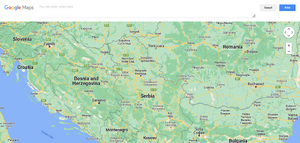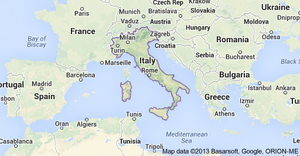Romania


Romania is a country located at the intersection of Central and Southeastern Europe, bordering on the Black Sea.
Origin of name
Romania derives from the Latin word romanus, meaning "citizen of Rome".[1]
History
42,000-year-old some human remains were discovered in the "Cave With Bones", and being Europe’s oldest known remains they may have been among the first modern humans to have entered the continent.[2] The Neolithic-Age Cucuteni area in northeastern Romania was the western region of the earliest European civilization, known as the Cucuteni-Trypillian culture.[3] Also the earliest known salt works in the world is at Poiana Slatinei, near the village of Lunca in Romania; it was first used in the early Neolithic, around 6050 BC, by the Starčevo culture, and later by the Cucuteni-Trypillian culture in the Precucuteni period.[4] Evidence from this and other sites indicates that the Cucuteni-Trypillian culture extracted salt from salt-laden spring water through the process of briquetage.
The earliest written evidence of people living in the territory of present-day Romania, the Getae, comes from Herodotus, in his Histories book IV (c. 440 BC).[5] Territories located north of the Danube were inhabited by Dacians, who are considered to have belonged to the Getae tribes, mentioned by Herodotus, that were a branch of Thracian people. The Dacian kingdom reached its peak between 82 and 44 BC during the reign of Burebista.
Roman Emperor Domitian led military campaigns in the region between 87 and 88 AD at Tapae. Roman incursions happened again during the years 101–102 AD and 105–106 AD under Emperor Trajan, who successfully defeated Dacia and annexed its southwestern parts to the vast Roman Empire. The Dacian population subsequently underwent the ethno-linguistic process of Romanisation and the conquered parts became an imperial province called Dacia. Because of Dacia's rich ore deposits (especially gold and silver),[6] Rome brought colonists from all over the empire.[7] This introduced Vulgar Latin and started a period of intense romanisation that would give birth to the Proto-Romanian language.[8] [9]During the 3rd century AD, with the invasions of migratory populations, the Roman Empire was forced to pull out of Dacia around 271 AD, making it the first province to be abandoned.[10][11]
After the Roman army and administration left Dacia, the territory was invaded by various migratory populations including Goths,[12] Huns,[13] Slavs, Gepids,[14] Avars,[15] Bulgars,[16] Pechenegs,[17] and Cumans.[18] Several competing theories have been proposed to explain the origin of modern Romanians. Linguistic and geo-historical analysis tend to indicate that Romanians coalesced as a major ethnic group both south and north of the Danube in the regions previously colonized by Romans.[19]
Jat History
- Getae: Scholars have suggested that "Getae" is the Greco-Latin variant of "Goth".[20][21][22][23] Alexander Cunningham advocated, "Jat is the same word as Getæ, in all probability."[24]
- Gait (गैट) Geta (गेटा) Gaite(गैट) Get (गेट) Getae (गेट) is a Jat gotra. This gotra is originated from word Getae of Greek language used for Jats.[25]
External links
References
- ↑ Romania in Dictionary
- ↑ Zilhão, João (2006). "Neanderthals and Moderns Mixed and It Matters". Evolutionary Anthropology 15 (5): 183–195. doi:10.1002/evan.20110
- ↑ John Noble Wilford (1 December 2009). "A Lost European Culture, Pulled From Obscurity". The New York Times (30 November 2009).
- ↑ Patrick Gibbs. "Antiquity Vol 79 No 306 December 2005 The earliest salt production in the world: an early Neolithic exploitation in Poiana Slatinei-Lunca, Romania Olivier Weller & Gheorghe Dumitroaia". Antiquity.ac.uk.
- ↑ Herodotus (1859). The Ancient History of Herodotus By Herodotus [William Beloe]. Derby & Jackson. pp. 213–217. ISBN 0-19-521974-0.
- ↑ "Dacia-Province of the Roman Empire". United Nations of Roma Victor. Retrieved 2008-01-10. "and were found in great quantities in the Western Carpathians. After Trajan's conquest, he brought back to Rooven ore than 165 tons of gold and 330 tons of silver"
- ↑ Deletant, Dennis (1995). Colloquial Romanian. New York: Routledge. p. 1. ISBN 978-0-415-12900-8.
- ↑ Matley, Ian (1970). Romania; a Profile. Praeger. p. 85.
- ↑ Giurescu, Constantin C. (1972). The Making of the Romanian People and Language. Bucharest: Meridiane Publishing House. pp. 43, 98–101, 141.
- ↑ Eutropius; Justin, Cornelius Nepos (1886). Eutropius, Abridgment of Roman History. London: George Bell and Sons. Retrieved 2008-08-31.
- ↑ Watkins, Thayer. "The Economic History of the Western Roman Empire"
- ↑ Jordanes (551 AD.). Getica, sive, De Origine Actibusque Gothorum. Constantinople. Retrieved 2008-08-31.
- ↑ Iliescu, Vl.; Paschale, Chronicon (1970). Fontes Historiae Daco-Romanae II. București. pp. 363, 587.
- ↑ Teodor, Dan Gh. (1995). Istoria României de la începuturi până în secolul al VIII-lea 2. București. pp. 294–325.
- ↑ Bóna, István (2001). Köpeczi, Béla, ed. "History of Transylvania: II.4. The Period of the Avar Rule" 1. New York: Institute of History of the Hungarian Academy of Sciences, Columbia University Press. Retrieved 2008-08-31.
- ↑ Teodor, Dan Gh. (1995). Istoria României de la începuturi până în secolul al VIII-lea 2. București. pp. 294–325.
- ↑ Constantine VII, Porphyrogenitus (950). Constantine Porphyrogenitus De Administrando Imperio. Constantinople. Retrieved 2008-08-31.
- ↑ Xenopol, Alexandru D. (1896). Histoire des Roumains i. Paris. p. 168.
- ↑ Ghyka, Matila (1841). "A Documented Chronology of Roumanian History". Oxford: B. H. Blackwell Ltd. Archived from the original on 2007-01-25.
- ↑ Common Origin of Croats, Serbs and Jats
- ↑ Lozinksi 1964: "The Name Slav" by B. Philip Lozinski (Essays in Russian History, Archon Books,1964)
- ↑ Vernadsky 1952: "Der sarmatische Hintergrund der germanischen Voelkerwanderung," (Sarmatian background of the Germanic Migrations), G. Vernadsky, Saeculum, II (1952), 340-347.
- ↑ Iranic Identity of Mauryas
- ↑ Cunningham, Arch. Survey Reports, II, 54 ff.
- ↑ Dr Mahendra Singh Arya etc,: Ādhunik Jat Itihas, p. 237
- ↑ Ram Sarup Joon:History of the Jats/Chapter V,p.104
Back to Places

